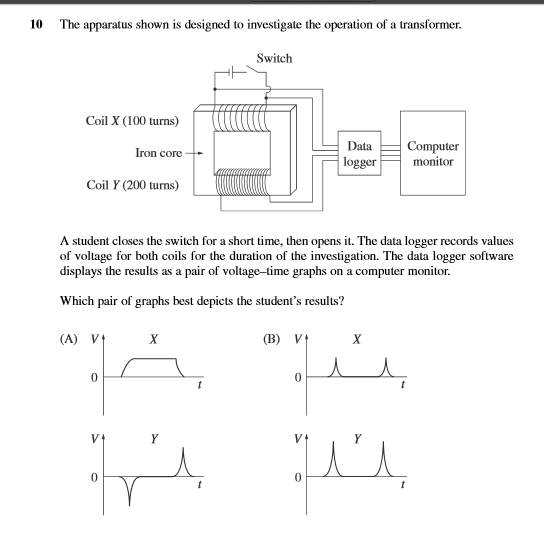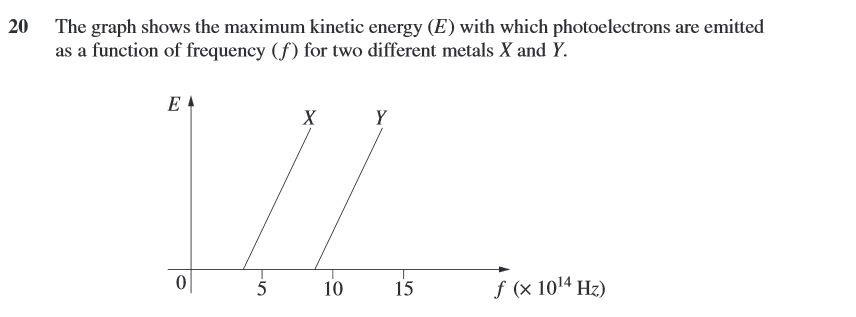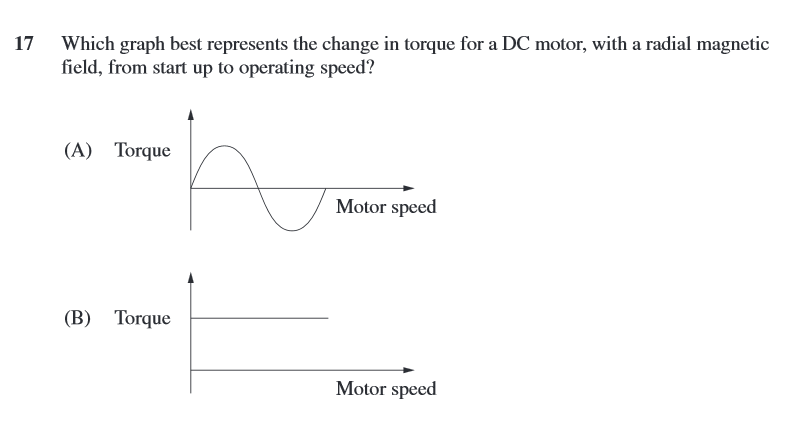-
Best of luck to the class of 2025 for their HSC exams. You got this! Let us know your thoughts on the HSC exams here
Make a Difference – Donate to Bored of Studies!
Students helping students, join us in improving Bored of Studies by donating and supporting future students!
HSC Physics MC Thread (1 Viewer)
- Thread starter Mr_Kap
- Start date
crankymidget
New Member
- Joined
- May 1, 2014
- Messages
- 3
- Gender
- Male
- HSC
- 2015
The disc is moving in same direction relative to the magnetic field. This creates creates a DC current. According to Lenz's law, the current will oppose the change in flux that created it. The disc is moving toward brush Y, therefore the current will flow from Y to X.
is that even legit reasonin??The disc is moving in same direction relative to the magnetic field. This creates creates a DC current. According to Lenz's law, the current will oppose the change in flux that created it. The disc is moving toward brush Y, therefore the current will flow from Y to X.
keepLooking
Active Member
- Joined
- Aug 25, 2014
- Messages
- 474
- Gender
- Male
- HSC
- 2015
Should be "WTF physics thread"
crankymidget
New Member
- Joined
- May 1, 2014
- Messages
- 3
- Gender
- Male
- HSC
- 2015
Haha. I couldn't illustrate my point very eloquently. MY reasoning was that the, the x brush is on the axel and the disc is rotating toward the y brush. Thats how I reasoned it in my head. I can't say for sure if this is correct, but it's the conclusion I came to.is that even legit reasonin??
I've had a look at some worked answers since and this is what i've found. "We know that because there is relative motion between the conductor and the magnetic field, a current will be induced. As the conductor is always moving in the same direction relative to the magnetic field, a direct current will be induced; hence the answer is either B or C.
We know that either the current will flow from X to Y (current flowing down), or Y to X (current flowing up). Also we know from Lenz’s Law that the induced current will be in such a direction that the magnetic field created by the induced current will oppose the original changing magnetic field. Hence the current must flow from Y to X for this to be true."
My excel success book says something similar, but does not give an answer as to working out the relative motion.
When the current is turned on in X, at the start a magnetic field is induced to oppose the increase in voltage, and therefore generate a back EMF, however it will eventually reach a constant voltage as it is a DC circuit and there will eventually be no magnetic field. A similar field will be created to oppose the voltage change when the switch is turned off but it will be in the opposite direction. Because there is only a changing magnetic field when the switch is turned off and on and not while it is operating at full voltage, a current will only be induced in coil Y when this field is changing, so therefore only when the switch at X is turned on and off. The induced voltage in Y when the switch is turned on will be in the opposite direction as that induced when the switch is turned off, so it would be A.And another fucked question. WHY IS THE ANSWER A? not B??:


What are the approimate work functions of both these metals??? is it where the lines start???
So is metal y at 9 and metal x at 4??
I though the work function is where the line meets the "KINETIC ENERGY" axis (y-intercept), and the absolute value of that is the work function??

What are the approimate work functions of both these metals??? is it where the lines start???
So is metal y at 9 and metal x at 4??
I though the work function is where the line meets the "KINETIC ENERGY" axis (y-intercept), and the absolute value of that is the work function??
kawaiipotato
Well-Known Member
- Joined
- Apr 28, 2015
- Messages
- 463
- Gender
- Undisclosed
- HSC
- 2015
Yes you're correct.
What are the approimate work functions of both these metals??? is it where the lines start???
So is metal y at 9 and metal x at 4??
I though the work function is where the line meets the "KINETIC ENERGY" axis (y-intercept), and the absolute value of that is the work function??
Note that
nevermind already done above
Zlatman
Member
- Joined
- Nov 4, 2014
- Messages
- 73
- Gender
- Male
- HSC
- 2015
The line has the formula: EK = hf - W
What are the approimate work functions of both these metals??? is it where the lines start???
So is metal y at 9 and metal x at 4??
I though the work function is where the line meets the "KINETIC ENERGY" axis (y-intercept), and the absolute value of that is the work function??
So yeah, when the value of the work function occurs when the frequency is zero, i.e. the y-intercept (as you said).
But, we can also find it out using the x-intercepts. When EK = 0, W = hf.
The THRESHOLD FREQUENCY for Metal X is at 4 x 10^-14 and for Metal Y is at 9 x 10^-14. Therefore, the WORK FUNCTION for Metal X is h * (4 x 10^-14) and the work function for Metal Y is h * (9 x 10^-14).
(LOL, NEVER MIND AGAIN - done above twice)

What are the approimate work functions of both these metals??? is it where the lines start???
So is metal y at 9 and metal x at 4??
I though the work function is where the line meets the "KINETIC ENERGY" axis (y-intercept), and the absolute value of that is the work function??
This is like the 5th time this week LOLThe line has the formula: EK = hf - W
So yeah, when the value of the work function occurs when the frequency is zero, i.e. the y-intercept (as you said).
But, we can also find it out using the x-intercepts. When EK = 0, W = hf.
The THRESHOLD FREQUENCY for Metal X is at 4 x 10^-14 and for Metal Y is at 9 x 10^-14. Therefore, the WORK FUNCTION for Metal X is h * (4 x 10^-14) and the work function for Metal Y is h * (9 x 10^-14).
(LOL, NEVER MIND AGAIN - done above twice)
Zlatman
Member
- Joined
- Nov 4, 2014
- Messages
- 73
- Gender
- Male
- HSC
- 2015
ikr, ffs, need to get faster at typing up my answers, lolThis is like the 5th time this week LOL
Its where it meets the y-axis, so if you have the equation hf=hf0+KE and you re arrange it to give your variables as KE and f, then you get KE=hf-hf0 then in the form y=mx+b, you get the y intercept to equal -hf0, which is also equal to the work function, and the gradient is equal to h from mx=hf
What are the approimate work functions of both these metals??? is it where the lines start???
So is metal y at 9 and metal x at 4??
I though the work function is where the line meets the "KINETIC ENERGY" axis (y-intercept), and the absolute value of that is the work function??

i thought it would be an INCREASING straight line.
Because it is a radial magnetic field and THETA is always 0 degrees it must be some form of straiht line, but i thought if it speeds up then the torqu needs to be larger
EDIT: I READ THE ANSWER WRONG. IT WAS D which was a straight line with negative gradient
Last edited:
vitamin D
Active Member
2014 question 15 (sorry dont know how to post pics on here yet)
my bad.
Why is it B?
i thought it would be an INCREASING straight line.
Because it is a radial magnetic field and THETA is always 0 degrees it must be some form of straiht line, but i thought if it speeds up then the torqu needs to be larger
misread the answer. The answer was D ---> the one with a decreasing straght line
Last edited:
vitamin D
Active Member
"radial" means constant torque, hence the straight line for torque. Not good enough at phys to explain in depth, sorry!
Why is it B?
i thought it would be an INCREASING straight line.
Because it is a radial magnetic field and THETA is always 0 degrees it must be some form of straiht line, but i thought if it speeds up then the torqu needs to be larger
edit: just saw the real answer, ignore everything i said.
Last edited:


